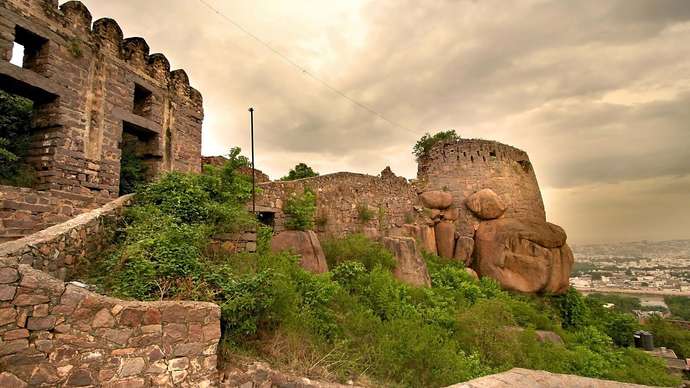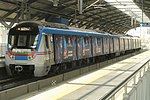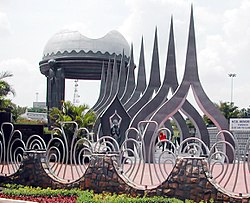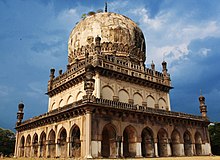hyderabad
hyderabad
Hyderabad is the capital and largest city of the Indian state of Telangana and the de jure capital of Andhra Pradesh. It occupies 650 km2 (250 sq mi) on the Deccan Plateau along the banks of the Musi River, in the northern part of South India. With an average altitude of 542 m (1,778 ft), much of Hyderabad is situated on hilly terrain around artificial lakes, including the Hussain Sagar lake, predating the city’s founding, in the north of the city centre. According to the 2011 Census of India, Hyderabad is the fourth-most populous city in India with a population of 6.9 million residents within the city limits, and has a population of 9.7 million residents in the metropolitan region, making it the sixth-most populous metropolitan area in India. With an output of US$74 billion, Hyderabad has the fifth-largest urban economy in India.
Muhammad Quli Qutb Shah established Hyderabad in 1591 to extend the capital beyond the fortified Golconda. In 1687, the city was annexed by the Mughals. In 1724, Mughal Viceroy Nizam Asaf Jah I declared his sovereignty and founded the Asaf Jahi dynasty, also known as the Nizams. Hyderabad served as the imperial capital of the Asaf Jahis from 1769 to 1948. As capital of the princely state of Hyderabad, the city housed the British Residency and cantonment until Indian independence in 1947. Hyderabad was annexed by the Indian Union in 1948 and continued as a capital of Hyderabad State (1948–56). After the introduction of the States Reorganisation Act of 1956, Hyderabad was made the capital of the newly formed Andhra Pradesh.
HISTORY
In 1713, Mughal emperor Farrukhsiyar appointed Mubariz Khan as Governor of Hyderabad. During his tenure, he fortified the city and controlled the internal and neighbouring threats.[32] In 1714 Farrukhsiyar appointed Asaf Jah I as Viceroy of the Deccan—(administrator of six Mughal governorates) with the title Nizam-ul-Mulk (Administrator of the Realm). In 1721, he was appointed as Prime Minister of the Mughal Empire.[34] His differences with the court nobles led him to resign from all the imperial responsibilities in 1723 and leave for Deccan.[35][36] Under the influence of Asaf Jah I’s opponents, Mughal Emperor Muhammad Shah issued a decree to Mubariz Khan, to stop Asaf Jah I which resulted in the Battle of Shakar Kheda.[35]: 93–94 In 1724, Asaf Jah I defeated Mubariz Khan to establish autonomy over the Deccan, named the region Hyderabad Deccan, and started what came to be known as the Asaf Jahi dynasty. Subsequent rulers retained the title Nizam ul-Mulk and were referred to as Asaf Jahi Nizams, or Nizams of Hyderabad.[32][33] The death of Asaf Jah I in 1748 resulted in a period of political unrest as his sons and grandson—Nasir Jung (1748–1750), Muzaffar Jang (1750-1751) and Salabat Jung (1751-1762)—contended for the throne backed by opportunistic neighbouring states and colonial foreign forces. The accession of Asaf Jah II, who reigned from 1762 to 1803, ended the instability. In 1768 he signed the Treaty of Masulipatam, surrendering the coastal region to the East India Company in return for a fixed annual rent.[37]
In 1769 Hyderabad city became the formal capital of the Asaf Jahi Nizams.[32][33] In response to regular threats from Hyder Ali (Dalwai of Mysore), Baji Rao I (Peshwa of the Maratha Empire), and Basalath Jung (Asaf Jah II’s elder brother, who was supported by French General the Marquis de Bussy-Castelnau), the Nizam signed a subsidiary alliance with the East India Company in 1798, allowing the British Indian Army to be stationed at Bolarum (modern Secunderabad) to protect the state’s capital, for which the Nizams paid an annual maintenance to the British.
GEOGRAPHY
Hyderabad is 1,566 km (973 mi) south of Delhi, 699 km (434 mi) southeast of Mumbai, and 570 km (350 mi) north of Bangalore by road.[53] It is situated in the southern part of Telangana in southeastern India,[54] along the banks of the Musi River, a tributary of Krishna River located on the Deccan Plateau in the northern part of South India.[55][56][57] Greater Hyderabad covers 650 km2 (250 sq mi), making it one of the largest metropolitan areas in India.[58] With an average altitude of 542 m (1,778 ft), Hyderabad lies on predominantly sloping terrain of grey and pink granite, dotted with small hills, the highest being Banjara Hills at 672 m (2,205 ft).[57][59] The city has numerous lakes sometime referred to as sagar, meaning “sea”. Examples include artificial lakes created by dams on the Musi, such as Hussain Sagar (built in 1562 near the city centre), Osman Sagar and Himayat Sagar.[57][60] As of 1996, the city had 140 lakes and 834 water tanks (ponds).[61]
Climate
Hyderabad has a tropical wet and dry climate (Köppen Aw) bordering on a hot semi-arid climate (Köppen BSh).[62] The annual mean temperature is 26.6 °C (79.9 °F); monthly mean temperatures are 21–33 °C (70–91 °F).[63] Summers (March–June) are hot and humid, with average highs in the mid-to-high 30s Celsius;[64] maximum temperatures often exceed 40 °C (104 °F) between April and June.[63] The coolest temperatures occur in December and January, when the lowest temperature occasionally dips to 10 °C (50 °F).[63] May is the hottest month, when daily temperatures range from 26–39 °C (79–102 °F); December, the coldest, has temperatures varying from 14.5–28 °C (58.1–82.4 °F).
ECONOMY

Recent estimates of the economy of Hyderabad’s metropolitan area have ranged from US$40-US$74 billion (PPP GDP), and have ranked it either fifth- or sixth- most productive metro area of India.[5] Hyderabad is the largest contributor to the gross domestic product (GDP), tax and other revenues, of Telangana, and the sixth largest deposit centre and fourth largest credit centre nationwide, as ranked by the Reserve Bank of India (RBI) in June 2012.[151] Its per capita annual income in 2011 was ₹44,300 (US$620).[152] As of 2006, the largest employers in the city were the state government (113,098 employees) and central government (85,155).[153] According to a 2005 survey, 77% of males and 19% of females in the city were employed.[154] The service industry remains dominant in the city, and 90% of the employed workforce is engaged in this sector.[155]
Hyderabad’s role in the pearl trade has given it the name “City of Pearls” and up until the 18th century, the city was the only global trading centre for diamonds known as Golconda Diamonds.[30][156][157] Industrialisation began under the Nizams in the late 19th century, helped by railway expansion that connected the city with major ports.[158][159] From the 1950s to the 1970s, Indian enterprises, such as Bharat Heavy Electricals Limited (BHEL), Nuclear Fuel Complex (NFC), National Mineral Development Corporation (NMDC), Bharat Electronics (BEL), Electronics Corporation of India Limited (ECIL), Defence Research and Development Organisation (DRDO), Hindustan Aeronautics Limited (HAL), Centre for Cellular and Molecular Biology (CCMB), Centre for DNA Fingerprinting and Diagnostics (CDFD), State Bank of Hyderabad (SBH) and Andhra Bank (AB)[133] were established in the city.[160] The city is home to Hyderabad Securities formerly known as Hyderabad Stock Exchange (HSE),[161] and houses the regional office of the Securities and Exchange Board of India (SEBI).[162] In 2013, the Bombay Stock Exchange (BSE) facility in Hyderabad was forecast to provide operations and transactions services to BSE-Mumbai by the end of 2014.
BANGALORE DISTRICT'S
Hyderabad (Urban) District in its present shape has come into existence in August, 1978 consequent on formation of a new District, Ranga Reddy from the erstwhile Hyderabad District. All the rural areas of erst-while Hyderabad District have been included in Ranga Reddy District, while thearea of Muncipal Corporation of Hyderabad (Exclding a small part), Secunderabad Cantonment, Lalaguda and Osmania University are included in Hyderabad District. There are 64 villages in the District and they are grouped into erstwhile talukas, Viz., Charminar, Golconda, Musheerabad and Secunderabad.
Hyderabad is the capital of one of the most techno savvy state in India,Telangana. The previous name of this city was Bagyanagaram.This city is also called the ‘city of pearls’ because of the major dealing of pearls that is done from this part of the state. Hyderabad was founded in 1591 and planned as a grid with the Charminar at its centre. It has now grown well beyond the confines of the original walled city,to include a new town north of the Musi river, the Military Cantonment at Secunderabad and a burgeoning high-tech Estate, nicknamed “Cyberabad”.
The State capital being in this District, it is highly developed in all aspects. With a view to bringing up the administration to the door steps of the people to solve their problems upliftment of the people, the Government as a policy took a decision to restructure the Lower level administrative set-up in the state consequently, Revenue Mandal were setup.

more info
Hyderabad, city, Telangana state, south-central India. It is Telangana’s largest and most-populous city and is the major urban centre for all of south-central interior India. From 1956 to 2014 Hyderabad was the capital of Andhra Pradesh state, but, with the creation of Telangana from Andhra Pradesh in 2014, it was redesignated as the capital of both states.
Hyderabad is located on the Musi River in the heart of the Telangana Plateau, a major upland region of the Deccan (peninsular India). The city site is relatively level to the gently rolling terrain, at an elevation of about 1,600 feet (500 metres). The climate is warm to hot and monsoonal (i.e., marked by wet and dry periods), with moderate annual precipitation. Most rain falls during the wet monsoon months of June to October. Pop. (2001) city (district), 3,829,753; urban agglom., 5,742,036; (2011) city (district), 3,943,323; urban agglom., 7,677,018.

demographics
When the GHMC was created in 2007, the area occupied by the municipality increased from 175 km2 (68 sq mi) to 650 km2 (250 sq mi).[58][115] Consequently, the population increased by 87%, from 3,637,483 as of 2001 census to 6,809,970 as of 2011 census, 24% of which are migrants from elsewhere in India,[78]: 2 making Hyderabad the nation’s fourth most populous city.[1][3] As of 2011, the population density is 18,480/km2 (47,900/sq mi)[116] and the Hyderabad urban agglomeration had a population of 7,749,334 making it the sixth most populous urban agglomeration in the country.[3] as of 2011 census, there are 3,500,802 male and 3,309,168 female citizens—a sex ratio of 945 females per 1000 males, higher than the national average of 926 per 1000.[117][118] Among children aged 0–6 years, 373,794 are boys and 352,022 are girls—a ratio of 942 per 1000. Literacy stands at 83% (male 86%; female 80%), higher than the national average of 74.04%.[117][119] The socio-economic strata consist of 20% upper class, 50% middle class and 30% working class.
| Hyderabad population | |||
|---|---|---|---|
| Census | Population | %± | |
| 1951 | 1,085,722 | — | |
| 1961 | 1,118,553 | 3.0% | |
| 1971 | 1,796,000 | 60.6% | |
| 1981 | 2,546,000 | 41.8% | |
| 1991 | 3,059,262 | 20.2% | |
| 2001 | 3,637,483 | 18.9% | |
| 2011 | 6,809,970 | 87.2% | |
transport
hyderabad metro
The Hyderabad Metro is a rapid transit system, serving the city of Hyderabad, Telangana, India.[5][6] It is the second longest operational metro network in India after the Delhi Metro (285 stations) with 57 stations[7][8] and the lines are arranged in a secant model. It is funded by a public–private partnership (PPP),[9][10] with the state government holding a minority equity stake.

bus
Telangana State Road Transport Corporation (abbreviated as TSRTC) is a state-owned corporation that runs bus transport services to and from the Indian state of Telangana. It was formed in 2014 by splitting the Andhra Pradesh State Road Transport Corporation.[2] Many other Indian metro towns in Andhra Pradesh, Tamil Nadu, Karnataka, Maharashtra, Goa, Odisha and Chhattisgarh are also linked with the services of TSRTC. It serves about 1 crore passengers every day, having three zones and services operating through 97 depots.

AIRPORT
Rajiv Gandhi International Airport (IATA: HYD, ICAO: VOHS) is an international airport that serves Hyderabad, the capital of the Indian state of Telangana. It is located in Shamshabad, about 24 kilometres (15 mi) south of Hyderabad. It was opened on 23 March 2008 to replace Begumpet Airport. It is named after Rajiv Gandhi, former Prime Minister of India. It has also ranked in AirHelp’s list of top 10 airports in the world.[4] In FY-2021, for the first time, Rajiv Gandhi International Airport over took Chennai to become fourth busiest airport in India by passengers traffic. It handled 8.04 million passengers between April 2020 and March 2021.[5]
The airport has one passenger terminal, a cargo terminal and two runways. There are also aviation training facilities, a fuel farm, a solar power plant and two MRO facilities

RESEDENTIAL AREAS
BLANK MAM

MARKET(afzal gunj)
Afzal Gunj is one of the part in Old City, Hyderabad, Telangana, India, close to river Musi. Afzal Gunj is the hub of local transportation due to the presence of Central Bus Station in the region. The bus station provides services to most of parts in the city.[1]
The famous Osmania General Hospital, Telangana State Central Library and Telangana High Court are located here. Other landmarks such as the Charminar and nearby monuments, Purani Haveli, and the Salar Jung Museum are located nearby.

SHOPPING MALL (hyderabad central MALL)
Hyderabad Central is a shopping mall in Hyderabad, India, located on the Punjagutta road.[1] The mall includes Marks and Spencer, as well as a range of movies, music, books, coffee shops, a food court, supermarket and restaurants.[1] The shopping space is spread over four levels,[1] with PVR Cinemas located on the top (fifth) floor with a total area of 250,000 sq.ft.
The mall was launched in November 2004 when the owners, Pantaloon Retail (India) Limited, at the same time also announced plans to create 12 to 15 malls across India within two years.[2] An investment of some 701 million rupees (approx. US$15.5 million) was made in this mall, which was the second large-scale mall in the country, the first being in Bangalore. In 2005, it was alleged that plans only showed four theatres, however after the construction of five theatres a lengthy legal battle ensued.

MOVIE THREATERS
Telugu cinema, also known as Tollywood, is the segment of Indian cinema dedicated to the production of motion pictures in the Telugu language, widely spoken in the states of Andhra Pradesh and Telangana. Telugu cinema is based in Film Nagar, a neighbourhood of Hyderabad, India.[4] The nickname Tollywood is a portmanteau of the words Telugu and Hollywood.
Since 1909, filmmaker Raghupathi Venkaiah Naidu was involved in producing short films and travelling to different regions in Asia to promote film work. In 1921, he produced the silent film, Bhishma Pratigna.[6] He is cited as the father of Telugu cinema.

PARKS
NTR Gardens is a small public, urban park of 36 acres (0.15 km2; 0.056 sq mi) adjacent to Hussain Sagar lake in Hyderabad, India. It is named after the former Chief minister of Andhra Pradesh, N. T. Rama Rao. Constructed in several phases since 1999, the area that is predominantly a park is geographically located in the centre of the city, and is close to other tourist attractions such as Birla Mandir, Necklace Road and Lumbini Park. It is maintained by the Buddha Purnima Project Authority that functions under the directives of the Government of Telangana.

HOSPITALS
Yashoda Hospitals is a chain of hospitals based in Hyderabad, Telangana, India. It has branches in Somajiguda, Secunderabad, and Malakpet,[1] with another branch coming up in Hitec City.[2] All of its branches are NABH[3] and NABL[4] accredited.
It was recognised as a leading hospital for oncology in 2015 after becoming the first hospital to achieve the milestone of treating 10,000 patients using RapidArc technology.

hyderabad LOCAL AREAS
Ameerpet
Begumpet
SR Nagar
Prakash Nagar
Punjagutta
BalkampetSanathnagar
Bharat Nagar
Erragadda
Borabanda
Moti NagarKhairtabad
Somajiguda
Raj Bhavan Road
Lakdikapool
Saifabad
A.C. Guards
Masab Tank
Chintal BastiMusheerabad
Chikkadpally
Himayatnagar
Ashok Nagar
Domalguda
Hyderguda
Ramnagar
Azamabad
Adikmet
Nallakunta
Shanker Mutt
RTC X Roads
Bagh Lingampally
Vidyanagar
Amberpet
Tilaknagar
Golnaka
Barkatpura
Shivam Road
Jamia Osmania
Kachiguda
BadichowdiNampally
Abids
Aghapura
Koti
Bank Street
Boggulkunta
Secunderabad
Chilkalguda
Kavadiguda
MG Road (James Street)
Madannapet
Minister Road
Mylargadda
Namalagundu
Padmarao Nagar
Pan bazar
Parsigutta
Patny
Rani Gunj
RP Road
Sindhi Colony
Sitaphalmandi
Tarnaka
Secunderabad Cantonment
Bowenpally
Karkhana
Marredpally
Sikh Village
Trimulgherry
VikrampuriAfzal Gunj
Aliabad
Alijah Kotla
Asif Nagar
Azampura
Barkas
Bazarghat
Begum Bazaar
Chaderghat
Chanchalguda
Chandrayan Gutta
Chatta Bazaar
Dabirpura
Dar-ul-Shifa
Dhoolpet
Edi Bazar
Falaknuma
Karwan
Malakpet
Moghalpura
Jahanuma
Laad Bazaar
Lal Darwaza
Rein Bazar
HITEC City
Madhapur
Kondapur
Jubilee Hills
Banjara Hills
Film Nagar
Yousufguda
Srinagar colony
Gachibowli
Raidurg
Khajaguda
Manikonda
Nanakramguda
Shaikpet Hyderabad
Serilingampally
Chanda Nagar
Hafeezpet
Madeenaguda
Miyapur
Madina, Hyderabad
Maharajgunj
Mehboob ki Mehendi
Mir Alam Tank
Mozamjahi Market
Nawab Saheb Kunta
Nayapul
Noorkhan Bazar
Pisal Banda
Purana pul
Putlibowli
WE HELP YOU TO SELL
PHONE
+91-7558348349
info@retailmarketing.co.in
ADDRESS
:- Shriram Niwas, 261, Bahirat Galli, Gaothan, Shivajinagar, Pune, Maharashtra 411005 :- infinity mall, Phase D, Shastri Nagar, Andheri West, Mumbai, Maharashtra 400047 :- Haware Fantasia Business Park, 47, near, Inorbit Bypass, Sector 30A, Vashi, Navi Mumbai, Maharashtra 400703

